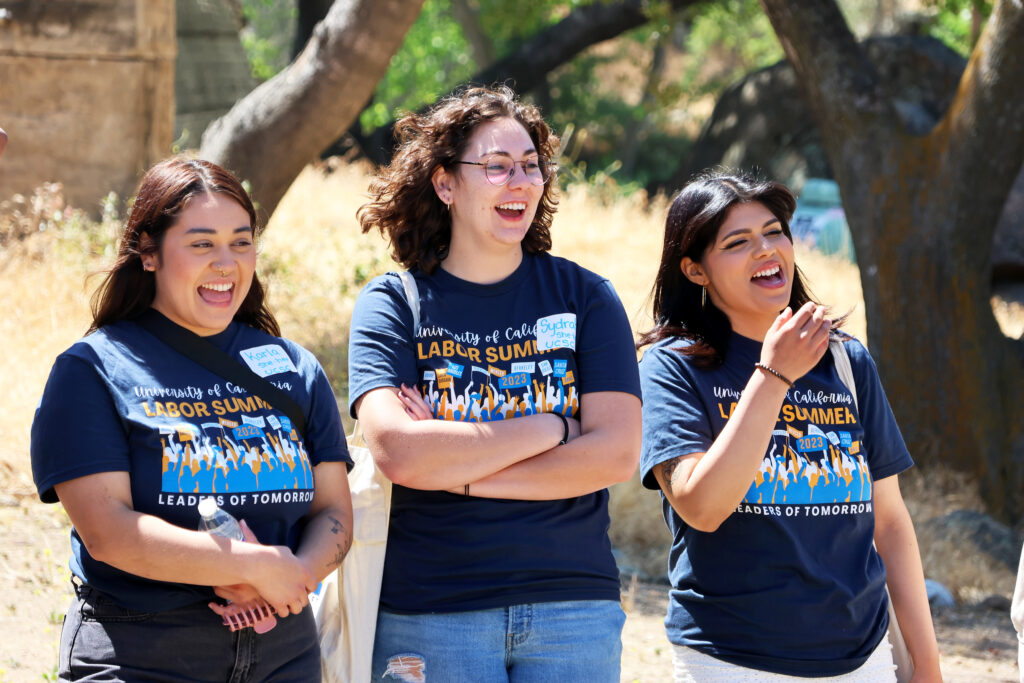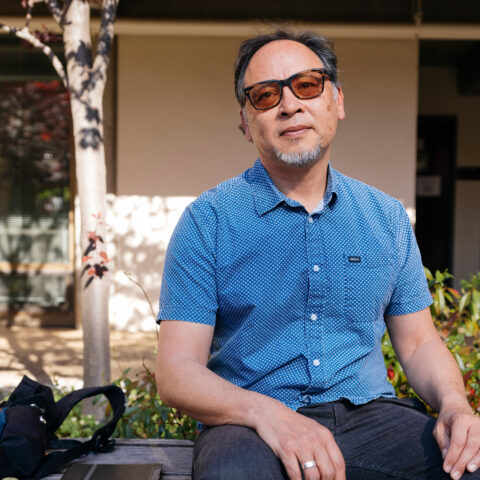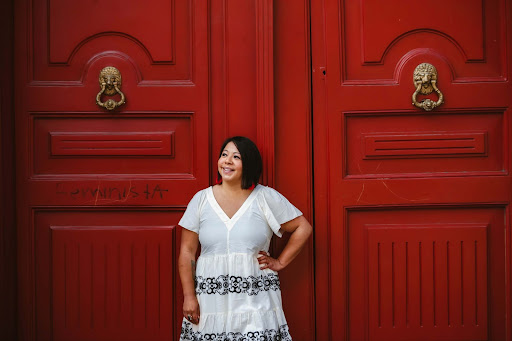Above: UC Santa Cruz Labor Summer dream team: (from left to right): Monterey Peninsula College students Leslie Villaruel and Max Herrera, Karla Martinez (Oakes ’24, Latin American and Latino studies and sociology), Nayeli Juarez (’24, politics), Sydrah Al-Saegh (Cowell ’23, critical race and ethnic studies), Ashley Gutierrez (Merrill ’25, psychology and sociology), Alma Villa (third-year Ph.D. in sociology), Dyana Huaraz (Porter ’23, Latin American and Latino studies and sociology), Jacqueline Avalos-Rodriguez (Kresge ’23, sociology), Daisy Corral-Jaimes (Stevenson ’23, sociology), and Professor Steve McKay
UC Santa Cruz’s Center for Labor and Community debuted its Labor Summer program in such perfect synchronicity with the recent organizing wave that came to be known as “hot labor summer” that it could have seemed … well, organized.
Labor Summer, the inaugural project of the UC-wide expansion of labor studies programs, saw six new centers joining the three established ones at UC Berkeley, UCLA, and UC Merced. During this time of widespread labor unrest, UC students from across the entire state and all nine undergraduate campuses participated in paid internships (receiving a $6,400 stipend) with labor unions and community organizations. Over 130 students took part, including 10 at UC Santa Cruz.

UCSC Labor Summer interns laughing during a visit to the Cesar E. Chavez National Monument in Keene, Calif., during orientation week. From left to right: Karla Martinez, Sydra Al-Saegh, Daisy Corral-Jaimes. (Photo courtesy Rosa Navarro)
Meanwhile, as Labor Summer students took on their assignments, “hot labor summer” was raging: The Writers Guild of America and the Screen Actors Guild-American Federation of Television and Radio Artists were on strike together for the first time in 63 years. UPS workers avoided a strike via successful wage-increase negotiations by the International Brotherhood of Teamsters labor union. And in Los Angeles, hotel workers organized a strike that, locally, came to include Santa Cruz’s own Dream Inn.
UCSC Labor Summer interns participated in the Dream Inn action, talking to workers who voted unanimously to go on strike as they renegotiated their contract—truly a frontline experience. Picket line, that is.
Collaborative organizing
The Center for Labor and Community—originally founded in 2007 as the Center for Labor Studies—examines the labor movement, economy, and the impacts of both on working people in California and beyond. The new center, which opened in March, connects “students, faculty, policy-makers and labor and community stakeholders,” per its mission statement, and aims to expand “research, policy analysis and public programming on key issues,” including affordable housing, worker organizing, and building strong unions.

Professor of Sociology Steve McKay (photo by Elena Zhukova)
Professor of Sociology Steve McKay, who has served as its director since 2010, says that “at UC Santa Cruz, our expanded Center for Labor and Community is taking off, and Labor Summer was an exciting project bringing together students, faculty, community, and labor partners right from the start. Our students come from a wide range of backgrounds with a broad diversity of skills and experiences.”
McKay cites a key highlight of Labor Summer as connecting the interns with “the people, organizations, and tools that help fight for social justice on a daily basis.”
Students committed to social and economic justice participated in a range of labor-organizing work, including defending affordable housing for farmworkers, marching with hotel employees to win livable wages, and speaking one-on-one with agricultural workers about their health issues.
It’s work that third-year sociology Ph.D. student and Labor Summer program’s principal organizer Rosa Navarro knows firsthand; Navarro comes from a background in labor organizing, having organized domestic workers and day laborers.
That background is “one of the reasons I helped coordinate Labor Summer,” she says. Navarro was also involved in rebuilding the Center for Labor and Community under Professor McKay, who is her main adviser at UC Santa Cruz.
Navarro helped plan, recruit, train, and coordinate the interns. She also collaborated with the Monterey Bay Central Labor Council and labor and community organization hosts.
As a UC Berkeley Labor Summer alum from 2021, Navarro was familiar with the Labor Summer program at that institution; so, she says, “it felt natural for me to help develop our program at Santa Cruz.” UC Santa Cruz’s first experience running Labor Summer “was really a team effort,” Navarro says. Along with UCLA, UC Merced, and UC Berkeley, UC Santa Cruz pressured the state to provide funding to UCs to develop new Labor Centers because of the increase in labor organizing.
Navarro was grateful for meetings every two weeks with UC Merced and UC Santa Barbara “throughout the whole process to check in and get feedback,” she says. “That helped that we weren’t building things from scratch.” Existing models from Berkeley and Merced helped not only to create the program, but also to build community among the UCs.
Onsite learning
The heart of the program is an effort to develop the next generation of organizers and leaders.

Rosa Navarro, third-year sociology Ph.D. student and Labor Summer program principal organizer (photo courtesy Rosa Navarro)
“Labor Summer originated at UC Berkeley over 20 years ago,” Navarro explains. “It was a way for Berkeley and the Berkeley Labor Center to connect students to the labor movement. It’s often referred to as the ‘school-to-labor-movement pipeline.’”
So, although it’s labeled as an internship, “they’re really organizers-in-training,” she adds.
The program placed two interns per site.
“We made sure to pair everyone up at a site so they had someone to work with, to not feel isolated by suddenly being thrown into a union,” Navarro says.
At Teamsters Local 890, interns Karla Martinez (Oakes ’24) and Dyana Huaraz (Porter ’23), both majoring in Latin American and Latino studies and sociology, “were thrown into an actual organizing campaign, which was really exciting,” Navarro says. The pair were taken under the wing of lead organizers and sent to Santa Maria, Calif., where they were organizing a 300-person factory.
“They were getting union card commitments signed, talking to workers, showing up really early at like 4 or 5 in the morning before the shifts started to talk to the workers when they showed up, to get them to come to the union meetings—hands-on organizing training, being actual organizers,” Navarro describes.
Interns also “worked on campaigns and background research,” Navarro says, such as, through United Food and Commercial Workers Union Local 5, organizing los cultivadores in the cannabis industry—workers in the greenhouses cultivating the product.
“They drove around, seeing where the farmhouses were and tracking down background research on the dispensaries themselves: seeing when shift changes were, how many workers were on the farms—information not given publicly,” says Navarro.
Overall, day-to-day activities always varied.
“A lot of them constantly attended rallies and different protests,” Navarro says.

Jacqueline Avalos-Rodriquez, a 2023 UC Santa Cruz Labor Summer intern (photo courtesy Rosa Navarro)
First-generation Mexican American student and Labor Summer participant Jacqueline Avalos-Rodriguez (Kresge ’23, sociology), whose site was United Food and Commercial Workers International Union Local 5 in Salinas, worked on probing “employees of cannabis cultivation sites for interest in unionization,” she says. “I had a general understanding of what a union was, but during the duration of my internship, I had the opportunity to learn industry insights and workplace dynamics, plus gain professional development.”
Avalos-Rodriguez, who was born and raised in Watsonville and is a self-identified nontraditional college student in her 30s, says she was able to strengthen her ability “to articulate and defend labor issues, conduct negotiation tactics with employers, and advocate for fair labor practices while adapting to changing circumstances.”
The opportunity to be part of the Labor Summer organizing program was critical to what Navarro calls the interns’ “great transformations in wanting to become labor organizers and continue in the labor movement.” As a result of Labor Summer, Avalos-Rodriguez decided to shift her academic focus to labor and immigration law. Labor Summer “strengthened my commitment to equity and ongoing professional development,” she says.
To wrap up the dynamic experience, “We had the graduation with the nine UCs in Oakland, hosted by UC Berkeley,” says Navarro.
Site insights
Labor Summer was rewarding not only for the organizers-in-training, but also for site representatives. Key organizers agreed, expressing gratitude and appreciation for the Labor Summer program and its student interns who came to work on their sites.
Efrain Aguilera, union representative and organizer for the United Food and Commercial Workers International Union Local 5, oversaw Avalos-Rodriguez and coparticipant Ashley Gutierrez (Merrill ’25, psychology and sociology).
“They were very professional in the way they worked among themselves to get the job done by dividing the tasks,” he says. “They all did a good job on researching active licensee cannabis companies within Monterey County. Their bilingual expertise made a difference to our summer organizing drive.”

UCSC Labor Summer team taking a group photo during a visit to the Cesar E. Chavez National Monument during orientation week. Left to right: Professor Steve McKay, Max Herrera, Daisy Corral-Jaimes, Sydra Al-Saegh, Nayeli Juarez, Alma Villa, Leslie Villaruel, Dyana Huaraz, (front) Karla Martinez, Rosa Navarro, and Ashley Gutierrez. (Photo courtesy Rosa Navarro)
President and Principal Officer of Teamsters Local 890 Crescencio Diaz praised his Labor Summer student interns, Martinez and Huaraz, as “phenomenal,” citing their engagement and participation in an organizing drive. Martinez and Huaraz said they had a fantastic experience working with Teamsters 890; Diaz concurred that the positive experience was mutual.
“After educating them in what labor organizations are, and what the Teamsters Union is in particular, they learned what we stand for,” he says, adding, “The program is great.” He hopes that Labor Summer not only continues, but also expands. “Teamsters will welcome students who want to have the experience to visit worksites,” Diaz says. “It is important that students understand what labor stands for and what we do as unions.”
And this wish looks likely to come true. McKay, looking ahead to Labor Summer 2024, is already undertaking the planning process, including evolving and building upon past successes, continuing to work with “key labor groups and community organizations,” he says.
The center next hopes to build in a research component involving the students and community partners. This will help “train them in research methods while expanding and contributing to our knowledge base about work and working conditions here along the Central Coast,” McKay explains. “It’s a seminal moment for California labor and the working families of our state, and we’re excited to be part of it.”
Learn more about the expanding Center for Labor and Community.

